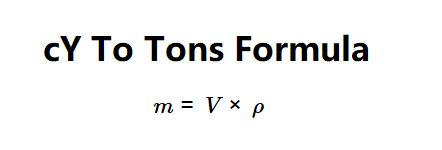1. What is Cubic Yards to Tons Converter?
Definition: This converter calculates the mass of a material given its volume in cubic yards (yd³) or cubic meters (m³), based on the material's density, and displays the result in metric tons (t), kilograms (kg), or US tons.
Purpose: It is used in construction, shipping, and material handling to estimate the weight of materials for transportation, storage, or project planning.
2. How Does the Converter Work?
The converter uses the following formula:
Formula:
- Mass: \[
m = V \times \rho
\]
Where:
- \( m \): Mass (in selected unit: t, kg, US ton)
- \( V \): Volume (in m³, converted from yd³ if necessary)
- \( \rho \): Density of the material (in kg/m³)
Unit Conversions:
- Volume:
- 1 yd³ = 0.764555 m³
- 1 m³ = 1 m³
- Mass:
- 1 t = 1000 kg
- 1 kg = 1 kg
- 1 kg = 0.00110231 US tons
Steps:
- Select the material from the dropdown list.
- Enter the volume and select its unit (yd³ or m³).
- Validate the input to ensure the volume is positive.
- Convert the volume to cubic meters (if in yd³).
- Calculate the mass in kilograms using the material's density.
- Convert the mass to the selected unit (t, kg, US ton).
- Display the result, using scientific notation for values less than 0.001, otherwise with 4 decimal places.
3. Importance of Cubic Yards to Tons Conversion
Converting volume to mass is crucial for:
- Construction: Estimating the weight of materials like concrete or wood for structural planning.
- Shipping: Determining the weight of cargo for transportation limits.
- Material Handling: Calculating the mass of bulk goods like flour or sugar for storage and logistics.
4. Using the Converter
Example:
Calculate the mass of 5 yd³ of concrete, displayed in metric tons.
- Select the material as Concrete (density = 2400 kg/m³).
- Enter the volume, \( V = 5 \, \text{yd}^3 \).
- Select the volume unit as yd³.
- Select the mass unit as t.
- The converter converts the volume to cubic meters:
- \( V = 5 \times 0.764555 \)
- \( V = 3.822775 \, \text{m}^3 \)
- Calculate the mass in kilograms:
- \( m = V \times \rho \)
- \( m = 3.822775 \times 2400 \)
- \( m = 9174.66 \, \text{kg} \)
- Convert to metric tons:
- \( m = 9174.66 / 1000 \)
- \( m = 9.17466 \, \text{t} \)
- The converter returns:
Another Example:
Calculate the mass of 2 m³ of gold, displayed in US tons.
- Select the material as Gold (density = 19300 kg/m³).
- Enter the volume, \( V = 2 \, \text{m}^3 \).
- Select the volume unit as m³.
- Select the mass unit as US ton.
- The volume is already in cubic meters: \( V = 2 \, \text{m}^3 \).
- Calculate the mass in kilograms:
- \( m = V \times \rho \)
- \( m = 2 \times 19300 \)
- \( m = 38600 \, \text{kg} \)
- Convert to US tons:
- \( m = 38600 \times 0.00110231 \)
- \( m = 42.5492 \, \text{US tons} \)
- The converter returns:
5. Frequently Asked Questions (FAQ)
Q: What is the Cubic Yards to Tons Converter?
A: The Cubic Yards to Tons Converter calculates the mass of a material given its volume in cubic yards or cubic meters, based on the material's density, and displays the result in metric tons, kilograms, or US tons.
Q: Why do densities vary for different materials?
A: Density depends on the material's composition and state (solid, liquid, gas). For example, metals like gold are much denser than gases like hydrogen, affecting the mass for the same volume.
Q: How is the Cubic Yards to Tons Converter used in real life?
A: It is used in construction to estimate material weights, in shipping to determine cargo loads, and in material handling to calculate the mass of bulk goods for storage and logistics.
Cubic Yards to Tons Converter© - All Rights Reserved 2025
 Home
Home
 Back
Back
